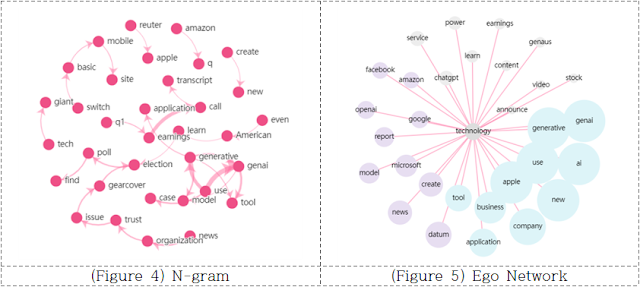"Generative AI"
Data Collection
Data collection was conducted as follows.
- Keywords: Generative AI, GenAI, Generative Artificial Intelligence
- Collection Duration: January 1, 2022 ~ April 30, 2024.
- Collection Channel: Google(facebook, news, web), youtube, yahoo
Generative artificial intelligence(generative AI, GenAI, or GAI) is artificial intelligence capable of generating text, images, videos, or other data using generative models, often in response to prompts. Generative AI models learn the patterns and structure of their input training data and then generate new data that has similar characteristics.(https://en.wikipedia.org/wiki/Generative_artificial_intelligence)
This technology is applied in various fields such as art creation, content generation, data augmentation, and simulation. Generative AI is particularly notable for automating creative tasks and enhancing human creativity. It is also used in developing realistic simulations, improving design processes, and generating synthetic data for training other AI models. The advancements in generative AI continue to expand its potential applications, making it a powerful tool in both industry and research.
(Figure 1) Interest over time in Generative AI
(Figure 1) is a graph about interest over time for the terms ‘Generative AI’, ‘GenAI’, and ‘Generative Artificial Intelligence’. It appears to show search volume on Google Trends. The y-axis shows interest level, with a value of 140 being the highest level depicted on the graph. The x-axis shows time from December 1, 2021 to April 30, 2024.
According to the graph, interest in ‘Generative AI’ started low in December 2021 and began to increase in late December 2022. It continued to increase until it reached a peak of 140 on June 4, 2023. Since then, interest has fluctuated but shows a general upward trend. As of the end of the data on April 30, 2024, interest remains high.
Top 30 ranked words associated with Generative AI
<Table 1> shows the frequency of words related to generative AI and their TF-IDF scores. TF-IDF stands for Term Frequency-Inverse Document Frequency. It is a statistic that reflects how important a word is to a document in a collection of documents. A higher TF-IDF score indicates that the word is both frequent in the document and infrequent in the document collection overall.
- Companies: Apple, Microsoft, OpenAI, Google, Facebook, Amazon
- Concepts: generative model, tool, service, power, content, earnings
- Actions: use, create, report, learn, use, announce
- Products: ChatGPT, video
(Figure 2) and (Figure 3) are vertical bar graphs of word frequency and TF-IDF, respectively.
(Figure 4) is the visualization result of N-gram. N-gram is a statistical language analysis model that extracts N consecutive elements from a text or sentence. TEXTOM provides a Bigram model with N=2. (Figure 5) is an ego network. In this network, technology belongs to ego.
(Figure 6) CONCOR Network
(Figure 6) is a visualization of a CONCOR analysis. As a result of CONCOR analysis, Generative AI networks were classified into four clusters.
- Cluster 1(pink): This group includes words like ‘iphone’, ‘product’, ‘software’, ‘organization’, ‘potential’, ‘sale’, ‘future’, ‘generate’ and ‘image’.
- Cluster 2(green): This group includes words like ‘world’, ‘launch’, ‘platform’, ‘and ’chatgpt’.
- Cluster 3(yellow): This group includes words like ‘service’, ‘content’, ‘power’, ‘facebook’, ‘google’, ‘amazon’, ‘openai’, ‘chatgpt’, and ‘learn’.
- Cluster 4(blue): This group includes words like ‘tool’, ‘application’, ‘datum’, ‘apple’, ‘company’, ‘technology’, ‘microsoft’, ‘business’, ‘genai’, and ‘model’.
(Figure 7) Word Cloud
(Figure 7) represents the word cloud related to Generative AI. A word cloud visually represents text data, displaying words in varying sizes and colors based on their frequency in the source text. The more frequent a word appears, the larger and bolder it is in the cloud.












.png)

![[Analysis Report] 2023 Israel-Hamas War: Armed Conflict, What is Hamas?](https://blogger.googleusercontent.com/img/b/R29vZ2xl/AVvXsEhDwJo4m2iZHP9UwSwVpkgMMfgtZt9YjXQCOhy6MP2N4rTLv2rEZcW75UCMTSvNOkZffLzU10agTBmAe4vqlzZePtEBdJi9Rq5Q8hmKVDJX1xuqUZcsLmmT9ym4H4HN0khOjLaBScN7DSK084VtRX63Y86eBFZkoe6YiKvA8ueGxj9EkKrSdDCaaE0T2L0/w72-h72-p-k-no-nu/noname01.png)
![[TEXTOM Manual] TF-IDF value calculation formula](https://blogger.googleusercontent.com/img/b/R29vZ2xl/AVvXsEg4A6ez5KZdNO6S57U-KfJFxHaY5T742eGHcB8GBf31otH69vvU3RebrGzIE8T2oMfFKqhqkI5UARdfHx8GP87m7SupOg717haMhorE_u06rz8d0v5fNHrxjEY6mYZKHPfw11nK_EqwLI5fvN2QdiqyPvdQrckeT8QKM2uwu_XdaSutArISjW22AGz7V-c/w72-h72-p-k-no-nu/tyle-y9n-12-1706516180.png)

0 Comments